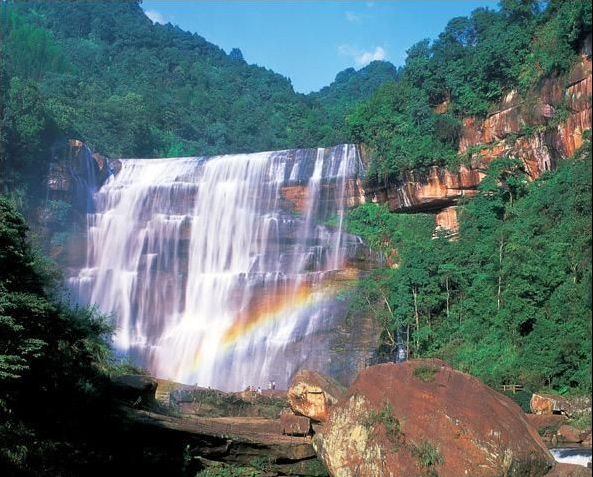Owing to its remote locations, the Chishui Waterfall was a secret until relatively recently. It was officially “discovered” during the Yongle Period of the Ming Dynasty (1368-1644), when an official stumbled across it. The official was responsible for transporting Nanmu, a special kind of local wooded plant, to the royal court. But he was so amazed by what he found that he found an excuse to remain in Chishui. He ended up settling down there, and stayed for 25 years. Subsequently, a Qing Dynasty historian wrote a poem as a record of the official’s time near his beloved waterfall.
The poem did not make the place well known, however. Fame came to it in the 1980s when plans were discussed for a local hydropower project. CCTV broadcast images of the waterfall to the nation for the first time on July 19, 1986, and soon after, tourists started to arrive in numbers.
There is much fine scenery around the Chishui Waterfall, including centuries-old pathways, karst stones, the Xiangxi Lake, tea fields and stalagmites. The spot is also home to much fauna, including the clouded leopard, milu deer and macaques.
Chishui is locally known as the city of a thousand waterfalls. Though this is likely a bit of an exaggeration, there are certainly a lot of them. Danxia Watersprings, the Sidonggou Waterfalls, the Yanziyan Waterfall… all have their own stories, legends and mysteries.
 |
|
The Shizhangdong Waterfall.
|
Jurassic Connection
Chishui’s National Nature Reserve is the world’s only protected zone for the ancient Spinulose Tree Fern. The trees are indigenous to the region, and the reserve is home to 40,000 of them.
Standing in front of these trees, I was thinking about news of a dinosaur fossil discovery in nearby Yunnan province. These trees have been around as long as that fossil, I thought. Perhaps the dinosaur – I forget which kind it was – even snacked on Spinulose leaves – they certainly looked big enough to make a meal for the now-extinct vertebrates.
The dinosaurs and the Spinulose Tree Fern once co-existed in the Jurassic Period of the Mesozoic Era from roughly 201 to 145 million years ago. The tree is now an enduring symbol of that time. Few of the species survived the climatic and geological vicissitudes that led to the current era. In China, the species can be found – in sparse numbers – in southern provinces of Yunnan, Sichuan and Fujian. In Guizhou province, however, their numbers are far greater. Many have tried introducing the trees, concentrated in Zunyi, into locales further north, but their attempts have generally been unsuccessful. Obviously there’s something special about Zunyi soil.
The trees are a monument to longevity. They still stand tall, while the majestic dinosaurs are long gone. Their biology provides scientists today with interesting insights into prehistoric times and evolutionary processes. The Chinese records on the trees dating from the 18th century show that 300 years ago locals were just as fascinated with the trees as scientists are today.
Spinulose Tree Fern in the protection zone can reach eight to nine meters in height. Average height is between four and six meters, and they grow less than one centimeter per year. The species has changed very little over 200 million years – tree trunks still stand tall and straight, and the umbrella-like branches that unfold at the top still features split leaves, which remind one of bird feathers.
We recommend:
